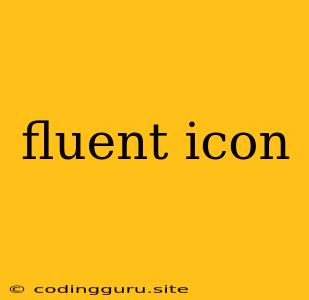Fluent Icons: A Comprehensive Guide to Microsoft's Design System
Fluent Icons are a growing collection of icons designed by Microsoft to provide a unified visual language across its products and services. They are designed to be accessible, consistent, and expressive, ensuring a seamless user experience. Whether you're a developer building a website, a designer creating a presentation, or simply looking for beautiful icons, Fluent Icons have something for you.
Why Choose Fluent Icons?
Here are some key advantages of using Fluent Icons:
- Consistency: Fluent Icons follow a consistent design system, ensuring that they look and feel cohesive across all your projects. This creates a unified brand experience for your users.
- Accessibility: Fluent Icons are designed with accessibility in mind, adhering to WCAG guidelines. This means they are easily understandable and usable by everyone, regardless of their abilities.
- Expressiveness: Fluent Icons are more than just simple shapes. They convey meaning through their design and animation, adding depth and richness to your interface.
- Open Source: Fluent Icons are open source, meaning you can use them for free in both personal and commercial projects.
- Extensive Library: The Fluent Icons library offers a wide range of icons covering various categories, from basic shapes to complex concepts. This means you're likely to find the perfect icon for your needs.
How to Use Fluent Icons
You can use Fluent Icons in multiple ways:
- Web Development: Fluent Icons can be easily integrated into your websites using CSS or SVG. Microsoft provides a comprehensive documentation on how to implement them in different frameworks.
- Design Tools: Fluent Icons are available as assets within various design tools like Figma, Sketch, and Adobe XD, allowing you to seamlessly incorporate them into your designs.
- Desktop Applications: Fluent Icons can also be used in desktop applications, allowing you to maintain consistency across your entire product portfolio.
- Mobile Applications: Fluent Icons are also available for mobile apps, ensuring your app's interface remains consistent across all platforms.
Key Features of Fluent Icons
Fluent Icons offer a set of features that enhance their usability and versatility:
- Multiple Sizes: Fluent Icons come in multiple sizes, allowing you to use them for various applications, from small buttons to large headers.
- Multiple Colors: Fluent Icons can be customized to match your brand colors, adding a personal touch to your interface.
- Animations: Certain icons support animations, adding a dynamic and engaging element to your interface. This can be particularly useful for conveying actions and states.
- Adaptive Design: Fluent Icons adapt to different screen sizes and orientations, ensuring they look great across all devices.
Getting Started with Fluent Icons
- Visit the Fluent UI website: You can find all the information you need about Fluent Icons, including documentation, usage guidelines, and the icon library on the Fluent UI website.
- Download the icon assets: You can download the icon assets in various formats, including SVG, PNG, and Font, depending on your project needs.
- Use the online tool: Microsoft also provides an online tool that allows you to search for specific icons and preview them before downloading them.
Fluent Icon Naming Conventions
Fluent Icons use clear and concise naming conventions to make it easier for you to find the icon you need. The names typically follow a pattern that describes the icon's purpose:
- General: This category includes basic icons like "home", "search", and "settings".
- Category: This category includes icons related to specific themes, like "calendar", "document", and "people".
- Action: This category includes icons that represent actions, like "add", "delete", and "save".
- State: This category includes icons that represent different states, like "checked", "disabled", and "loading".
Examples of Fluent Icons in Use
Fluent Icons are widely used across Microsoft products and services. Here are some examples:
- Microsoft Windows: Fluent Icons are used in the Windows Start menu, taskbar, and various system settings.
- Microsoft Office: Fluent Icons are used in the ribbon menus and toolbars of applications like Word, Excel, and PowerPoint.
- Microsoft Teams: Fluent Icons are used throughout the Teams interface, from chat icons to reactions.
Conclusion
Fluent Icons are a valuable tool for designers and developers looking to create engaging and user-friendly interfaces. Their consistent design system, accessibility features, and expressive nature make them an excellent choice for any project. By utilizing Fluent Icons, you can build a cohesive and visually appealing user experience that aligns with Microsoft's design principles.
